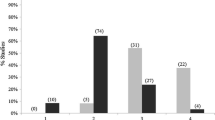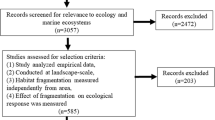Abstract
Context
Scale is the lens that focuses ecological relationships. Organisms select habitat at multiple hierarchical levels and at different spatial and/or temporal scales within each level. Failure to properly address scale dependence can result in incorrect inferences in multi-scale habitat selection modeling studies.
Objectives
Our goals in this review are to describe the conceptual origins of multi-scale habitat selection modeling, evaluate the current state-of-the-science, and suggest ways forward to improve analysis of scale-dependent habitat selection.
Methods
We reviewed more than 800 papers on habitat selection from 23 major ecological journals published between 2009 and 2014 and recorded a number of characteristics, such as whether they addressed habitat selection at multiple scales, what attributes of scale were evaluated, and what analytical methods were utilized.
Results
Our results show that despite widespread recognition of the importance of multi-scale analyses of habitat relationships, a large majority of published habitat ecology papers do not address multiple spatial or temporal scales. We also found that scale optimization, which is critical to assess scale dependence, is done in less than 5 % of all habitat selection modeling papers and less than 25 % of papers that address “multi-scale” habitat analysis broadly defined.
Conclusions
Our review confirms the existence of a powerful conceptual foundation for multi-scale habitat selection modeling, but that the majority of studies on wildlife habitat are still not adopting multi-scale frameworks. Most importantly, our review points to the need for wider adoption of a formal scale optimization of organism response to environmental variables.



Similar content being viewed by others
References
Addicott JF, Aho JM, Antolin MF, Padilla DK, Richardson JS, Soluk DA (1987) Ecological neighborhoods: scaling environmental patterns. Oikos 49:340–346
Aebischer NJ, Robertson PA, Kenward RE (1993) Compositional analysis of habitat use from animal radiotracking data. Ecology 74:1313–1325
Avgar T, Deardon R, Fryxella JM (2013) An empirically parameterized individual based model of animal movement, perception, and memory. Ecol Model 251:158–172
Beatty WS, Webb EB, Kesler DC, Raedeke AH, Naylor LW, Humburg DD (2014) Landscape effects on mallard habitat selection at multiple spatial scales during the non-breeding period. Landscape Ecol 29:989–1000
Boscolo D, Metzger JP (2009) Is bird incidence in Atlantic forest fragments influenced by landscape patterns at multiple scales? Landscape Ecol 24:907–918
Cohen J (1960) A coefficient of agreement for nominal scales. Educ Psychol Meas 20:37–46
Cushman SA, Raphael MG, Ruggiero LF, Shirk AS, Wasserman TN, O’Doherty EC (2011) Limiting factors and landscape connectivity: the American marten in the Rocky Mountains. Landscape Ecol 26:1137–1149
Cushman SA, Shirk AJ, Landguth EL (2013) Landscape genetics and limiting factors. Conserv Genet 14:263–274
DeCesare NJ, Hebblewhite M, Schmiegelow F, Hervieux D, McDermid GJ, Neufeld L, Bradley M, Whittington J, Smith KG, Morgantini LE, Wheatley M, Musiani M (2012) Transcending scale dependence in identifying habitat with resource selection functions. Ecol Appl 22:1068–1083
Delcourt HR, Delcourt PA, Webb T (1983) Dynamic plant ecology: the spectrum of vegetation change in space and time. Quat Sci Rev 1:153–175
Grand J, Buonaccorsi J, Cushman SA, Mello M, Griffin CR (2004) A multi-scale approach to predicting bird and moth rarity hot-spots in a threatened pitch pine-scrub oak community. Conserv Biol 18:1063–1077
Grand J, Cushman SA (2003) A multi-scale analysis of species–environment relationships: breeding birds in a pitch pine–scrub oak (Pinus rigida–Quercus ilicifolia) community. Biol Conserv 112:307–317
Guenard G, Legendre P, Boisclair D, Bilodeau M (2010) Multiscale codependence analysis: an integrated approach to analyze relationships across scales. Ecology 91:2952–2964
Haury LR, McGowan JA, Wiebe PH (1978) Patterns and processes in the time-space scales of plankton distributions. In: Steele JH (ed) Spatial pattern in plankton communities. Plenum, New York, pp 277–327
Holland JD, Bert DG, Fahrig L (2004) Determining the spatial scale of species’ response to habitat. Bioscience 54:227–233
Hutchinson GE (1965) The ecological theater and the evolutionary play. Yale University Press, New Haven
Indermaur L, Winzeler T, Schmidt BR, Tockner K, Schaub M (2009) Differential resource selection within shared habitat types across spatial scales in sympatric toads. Ecology 90:3430–3444
Jamoneau A, Chabrerie O, Closset-Kopp D, Decocq G (2012) Fragmentation alters beta-diversity patterns of habitat specialists within forest metacommunities. Ecography 35:124–133
Johnson D (1980) The comparison of usage and availability measurements for evaluating resource preference. Ecology 61:65–71
Kaufman L, Rousseeuw PJ (1990) Finding groups in data: an introduction to cluster analysis. Wiley, New York
Kuhn A, Copeland J, Cooley J, Vogel H, Taylor K, Nacci D, August P (2011) Modeling habitat associations for the Common Loon (Gavia immer) at multiple scales in northeastern North America. Avian Conserv Ecol 6(1):4
Latombe G, Fortin D, Parrott L (2014) Spatio-temporal dynamics in the response of woodland caribou and moose to the passage of grey wolf. J Anim Ecol 83:185–198
Leblond M, Frair J, Fortin D, Dussault C, Ouellet JP, Courtois R (2011) Assessing the influence of resource covariates at multiple spatial scales: an application to forest-dwelling caribou faced with intensive human activity. Landscape Ecol 26:1433–1446
Legendre P, Legendre L (1998) Numerical ecology, second edition. Elsevier Science B.V, Amsterdam
Levin SA (1992) The problem of pattern and scale in ecology: the Robert H. MacArthur Award Lecture. Ecology 73:1943–1967
Martin AE, Fahrig L (2012) Measuring and selecting scales of effect for landscape predictors in species–habitat models. Ecol Appl 22:2277–2292
Mayor SJ, Schneider DC, Schaefer JA, Mahoney SP (2009) Habitat selection at multiple scales. Ecoscience 16:238–247
McGarigal K, Cushman SA, Stafford SG (2000) Multivariate statistics for wildlife and ecology research. Springer, New York
McNew LB, Gregory AJ, Sandercock BK (2013) Spatial heterogeneity in habitat selection: nest site selection by greater Prairie-Chickens. J Wildl Manag 77:791–801
Meyer CB, Thuiller W (2006) Accuracy of resource selection functions across spatial scales. Divers Distrib 12:288–297
Norththrup JM, Hooten MB, Anderson CR Jr, Wittemyer G (2013) Practical guidance on characterizing availability in resource selection functions under a use-availability design. Ecology 94:1456–1463
Patterson TA, Thomas L, Wilcox C, Ovaskainen O, Matthiopoulos L (2008) State–space models of individual animal movement. Trends Ecol Evol 23:87–94
Pennington DN, Blair RB (2011) Habitat selection of breeding riparian birds in an urban environment: untangling the relative importance of biophysical elements and spatial scale. Divers Distrib 17:506–518
Poulin JF, Villard MA (2011) Edge effect and matrix influence on the nest survival of an old forest specialist, the Brown Creeper (Certhia americana). Landscape Ecol 26:911–922
Sáncheza MCM, Cushman SA, Saura S (2013) Scale dependence in habitat selection: the case of the endangered brown bear (Ursus arctos) in the Cantabrian Range (NW Spain). Int J Geogr Inf Sci 28:1531–1546
Schaefer JA, Messier F (1995) Habitat selection as a hierarchy: the spatial scales of winter foraging by muskoxen. Ecography 18:333–344
Schneider DC (2001) The rise of the concept of scale in ecology. Bioscience 51:545–553
Shirk AJ, Raphael MG, Cushman SA (2014) Spatiotemporal variation in resource selection: insights from the American marten (Martes americana). Ecol Appl 24:1434–1444
Stommel H (1963) Varieties of oceanographic experience. Science 139:572–576
Storch I (2003) Linking a multiscale habitat concept to species conservation. In: Bissonette JA, Storch I (eds) Landscape ecology and resource management: linking theory with practice. Island Press, Washington, pp 303–320
Tanferna A, López-Jiménez L, Blas J, Hiraldo F, Sergio F (2013) Habitat selection by Black kite breeders and floaters: implications for conservation management of raptor floaters. Biol Conserv 160:1–9
Thompson CM, McGarigal K (2002) The influence of research scale on bald eagle habitat selection along the lower Hudson River, New York (USA). Landscape Ecol 17:569–586
Wheatley M (2010) Domains of scale in forest-landscape metrics: implications for species-habitat modeling. Acta Oecol 36:259–267
Wheatley M, Johnson C (2009) Factors limiting our understanding of ecological scale. Ecol Complex 6:150–159
Wiens J (1976) Population responses to patchy environments. Annu Rev Ecol Syst 7:81–120
Wiens J (1989) Spatial scaling in ecology. Funct Ecol 3:385–397
Zeller KA, McGarigal K, Beier P, Cushman SA, Vickers TW, Boyce WM (2014) Sensitivity of landscape resistance estimates based on point selection functions to scale and behavioral state: pumas as a case study. Landscape Ecol 29:541–557
Acknowledgments
This work was supported by the National Science Foundation Graduate Research Fellowship under Grant No. DGE-0907995 (Zeller) and the Joint Fire Sciences Project # 12-1-06-56 (Wan, Timm, McGarigal, and Cushman). This manuscript was also improved by the suggestions of several anonymous reviewers.
Author information
Authors and Affiliations
Corresponding author
Electronic supplementary material
Below is the link to the electronic supplementary material.
Rights and permissions
About this article
Cite this article
McGarigal, K., Wan, H.Y., Zeller, K.A. et al. Multi-scale habitat selection modeling: a review and outlook. Landscape Ecol 31, 1161–1175 (2016). https://doi.org/10.1007/s10980-016-0374-x
Received:
Accepted:
Published:
Issue Date:
DOI: https://doi.org/10.1007/s10980-016-0374-x




